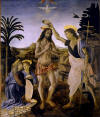Search:: Artists Alphabetically Artists by Country Artists by Century Artists by Movement
The Early Renaissance
1330 - 1470
The term Renaissance means “rebirth”
Artist Bio
Until the middle ages men regarded themselves as following the Good Shepherd, and art consequently did not recognize the individual in particular. Classical humanism, an itellectula movement based upon the texts of Roman and Greek orators and philosophers, was a crucial part of the Italian Renaissance. This philosophical movement was based on the idea that every persons life had value and dignity. Francesco Petrarch , 1304-1374, called the Father of Humanism, Italian Intellectual, Poet, and Humanist, wrote "Love is the crowning grace of humanity, the holiest right of the soul, the golden link which binds us to duty and truth, the redeeming principle that chiefly reconciles the heart of life, and is prophetic of eternal good."The style of painting began to change with the recognition of painters such as Giotto and Fra Angelico. In the structure and position of the figures, as in their expression, a general and uniform type of beauty prevailed. According to Hendrik van Loon, "They no longer concentrated all their thoughts and their efforts upon the blessed existence that awaited them in Heaven. They tried to establish their Paradise upon this planet, and, truth to tell, they succeeded in a remarkable degree."
The early Renaissance marks the victory of individualism and the uncompromising prominence of the individual. An abundance of sharply outlined characters suddenly appears, robust, clear-cut personalities; lawless nature belonging just as much in the gallery of criminals as in that of great men. Character, individuality, power and energy are the passwords of the Renaissance age. This new humanity, all these rugged and manly figures which the age had created, had also to appear in painting. In contrast to the former preference for beauty of an angelic and tender type, the problem now was to depict energetic and powerful beings; and to replace shy and feminine, though bearded, men in the pictures of the older masters by angular, harsh determined and daring types. The figures which has formerly hovered like spirits above the earth had now to stand firmly upon their own feet and become part of their earthly home.
The Early Renaissance was a time of great intellectual and spiritual awakening. Florentine artists took leadership in the development of a new style of painting focusing on ideal beauty. During the 15th century Patronage shifted from the church to the merchant class and wealthy patrons of the patrician class, such as the Medici family, began collecting and commissioning works of art. such as the Italian art world. Humanism was emerging, and religious devotion, though still an important part of people's lives, was being restructured to accommodate the belief that man can be master his own fate.
The standard of beauty was measured by rudimentary and uncompromising representation of individual qualities. This may best explain all the strange physiognomies witch suddenly made their appearance in art; course men of the people with uncouth, overworked figures; peasants, with bones of bronze and pointed weather beaten features; half starved old beggars with sagging flesh and tottering bodies; neglected fellows with bald heads, stubbly beards, and long muscular arms. In place of the former dainty pose, every line is now sinew. Their firm, energetic attitude reflects the entire sprit of the rugged age. -- Richard Muther, The History of Painting, Henry and Co., London, 1896
The most
profound change came with the introduction of the new technique of
painting in oils, developed in Flanders, and widely adopted in Italy
and elsewhere.
Key Descriptive Words and Phrases associated with the Renaissance Movement - rebirth, rediscovery of the classical world, City-state, Humanism, Humanist, Francesco Petrarch, Reform, The Prince, Theocracy, The Inquisition, Human Reasoning, publication of Della Pittura, a book about the laws of mathematical perspective for artists, sfumato, chiaroscuro, linear perspective, Heliocentric Theory, vanishing point, Savonarola, spiritually significant, illuminated manuscript, idealized biblical themes, scriptorium, emotion, illuminator, iconoclast, Age of Discovery, axonometric drawing, curiosity about the natural world, mythology, realistic use of colours and light, Bonfire of the Vanities, Old Testament stories, ethereal and foggy backgrounds, Gospel parables, The Blackdeath, romanticized landscapes, Christian symbolism. Paradise
☼☼☼☼☼
Require more facts and information about the painter and the artists of the renaissance era? Poke around every nook and cranny of the known universe for information this subject. Search Here
© HistoryofPainters.com If you like this page and wish to share it, you are welcome to link to it, with our thanks.
Famous Painters of the Early
Renaissance
Mariotto
Albertinelli
Fra
Angelico
Alesso
Baldovinetti
Lazzaro
Bastiani
Gentile
Bellini
Pedro
Berruguete
Sandro
Botticelli
Guidoccio
Cozzarelli
Bernardo
Daddi
Jean
Fouquet
Domenico
Ghirlandaio
Giovanni
di Paolo di Grazia
Giotto
di Bondone
Giovanni
di Paolo
Benozzo
Gozzoli
Fra
Filippo Lippi
Andrea
Mantegna
Masaccio
Pietro
Perugino
Piero
della Francesca
Sano
di Pietro
Sassetta
Paolo
Uccello
Andrea
del Verrocchio
